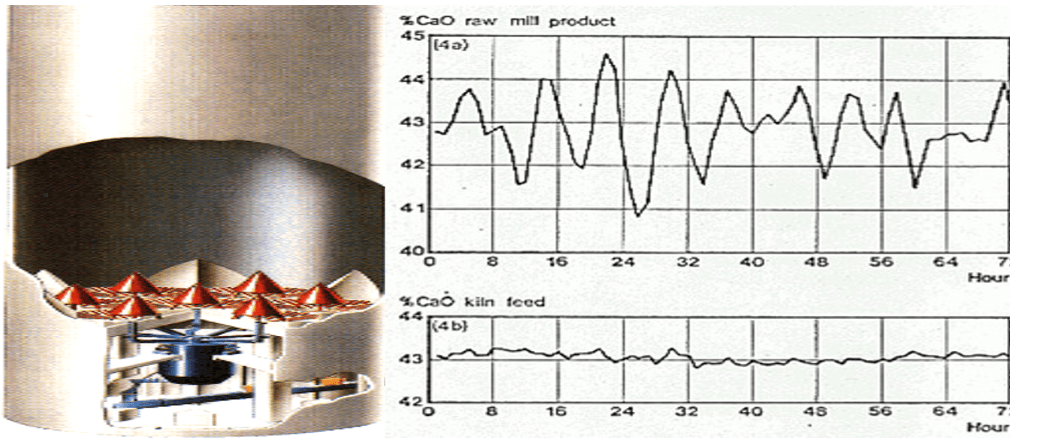
In preparing raw meal, raw materials like limestone, clay and iron ore are proportioned and fed to raw mill, where these raw materials are ground and well mixed. However, this mixing is not enough to produce clinker of uniform quality. For stable kiln operation and to obtain uniform quality of clinker it is necessary to keep the variation in kiln feed in LSF 0.5, in SM 0.03 and in AM 0.03 measured as a standard deviation.
 A specific blending operation is therefore necessary to produce kiln feed of quality that is consistently uniform in chemical composition and also particle size distribution. For cement plants of small capacities where preblending by staking-reclaiming was not a necessity, batch type blending (Air merge-turbulent blending) to achieve a blending ratio of 10-1 was enough to produce a consistent kiln feed. However, as the plant capacities grew bigger and bigger, Batch type silos to contain a buffer stock of 2-3 days (kiln feed) became unfeasible and the concept of continuous controlled silos of capacities as high as 15k-20k metric tons started to evolve. Modern designed controlled flow silos yielding a blending ratio of 3-5. Controlled flow silos may have multiple discharge points, or an inverted cone over a center discharge within which the raw meal is fluidised. In controlled flow silos, blending is achieved by differential rates of material descent within the silo by sequenced light aeration of segments of air-pads. Moreover, it is recommended to have a preblending system (staking-reclaiming) and a regular analysis of from raw mill feed or product by XRF to augment blending of raw meal to consistent kiln feed for good quality clinker formation and stable kiln operation
A specific blending operation is therefore necessary to produce kiln feed of quality that is consistently uniform in chemical composition and also particle size distribution. For cement plants of small capacities where preblending by staking-reclaiming was not a necessity, batch type blending (Air merge-turbulent blending) to achieve a blending ratio of 10-1 was enough to produce a consistent kiln feed. However, as the plant capacities grew bigger and bigger, Batch type silos to contain a buffer stock of 2-3 days (kiln feed) became unfeasible and the concept of continuous controlled silos of capacities as high as 15k-20k metric tons started to evolve. Modern designed controlled flow silos yielding a blending ratio of 3-5. Controlled flow silos may have multiple discharge points, or an inverted cone over a center discharge within which the raw meal is fluidised. In controlled flow silos, blending is achieved by differential rates of material descent within the silo by sequenced light aeration of segments of air-pads. Moreover, it is recommended to have a preblending system (staking-reclaiming) and a regular analysis of from raw mill feed or product by XRF to augment blending of raw meal to consistent kiln feed for good quality clinker formation and stable kiln operation
Primary parameters to be monitored for Silo are:
- Blending ratio (standard deviation of input/ standard deviation of output).
- Compressor kWh/tonne throughput.
Advantages of CF Silos over Batch Type Blending Silos.
- Low Compressor power consumption.
Turbulent mixing (air merge) 1.5 - 2.5 kWh/t.
Controlled flow, inverted cone 0.25 - 0.5 and for multi outlet 0.10-0.13 kWh/t. - Effective capacity of a CF silo is some 20% greater as the raw meal is not heavily aerated.
Caution:
Blending silos are very prone to internal build-up of dead material, particularly if feed material is moist or if segment aeration is defective. Re-circulation provision is always available in silos to recirculate raw meal during kiln shut-down or any inactive period to avoid internal build-ups. Therefore, it is recommended to do periodic (1-2 years) internal inspections and maintenance.
